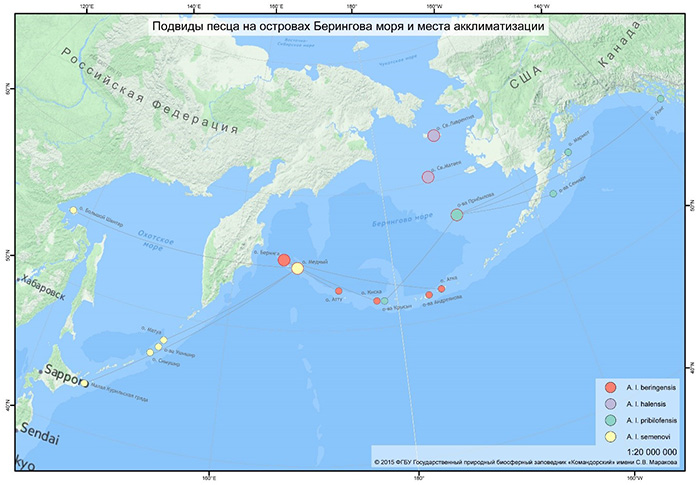The Arctic Fox
Subspecies V. l. beringensis Merriam, 1902, V. l. semenovi Ognev, 1931
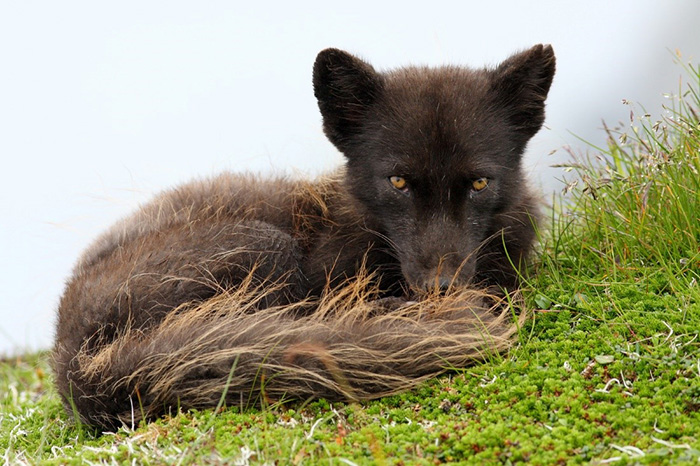
Arctic fox, Medny Island. Photograph by Eugene Mamaev
The body length of the Arctic fox which inhabits Bering Island is 46-67 cm (60 cm avg), the weight is 3,5-8,8 kg (5,5 kg avg); females are 41-64 см long(57 cm avg) and weigh 2,5-6,4 kg (4,4 kg avg). The body length of the Arctic fox which inhabits Medny Island is 61-73 cm (68 cm avg), the weight is 4-8,8 kg (7,2 kg avg); females are 60-68 cm long (64 cm avg), and weigh 4-7,2 kg (6 kg avg). Newborn pups can be 13 cm long and weigh up to 85 gm.
The Arctic fox is a species of carnivorous mammals with circumpolar distribution. The mainland Russia inhabits a subspecies of the Arctic fox - V. l. lagopus L., which is characterized by white fur color in winter. On the Commander Islands the Arctic fox is represented by a so-called "blue" Arctic fox. The color of fur of the island subspecies is smoky and gray-brown the whole year with slight variations in shades during different seasons. Bering Island inhabits a subspecies V. l. beringensis Merriam, 1902, and Medny Island – V. l. semenovi Ognev, 1931. In 1931Ognew S.I., describing the new subspecies of the Arctic fox from Medny Island, gave it the Latin name semenovi in honor of the famous scientist Semenov-Tyan-Shansky A.P. Apart from the two Commander subspecies in the basin of Bering Sea experts distinguish two more subspecies of island Arctic foxes: V. l. pribilofensis Merr., 1902, which inhabits the Pribilof Islands, and V. l. halensis Merr., 1900, which lives on Hall Island, St. Matthew Island and St. Lawrence Island.
Island subspecies of the Arctic fox in Bering Sea and the places of their acclimatization
It is believed that the Arctic fox appeared on the Commander Islands approximately 80 thousand years ago, and about 12 thousand years ago two subspecies were finally separated (the connection between the populations of the Arctic fox on Bering Island and on Medny Island ceased to exist). The Arctic fox could get to the islands during cold snap periods by ice.
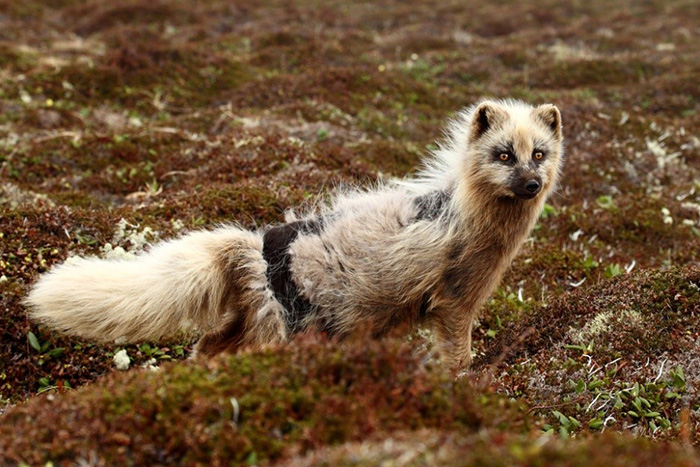
Moulting Arctic fox in spring. Photograph by Eugene Mamaev
The rut of Arctic foxes on the Commander Islands takes place in February-March (deadlines are from the end of January till the beginning of May). Pregnancy lasts 49-56 days. Puppies are born in May-June (there have been cases when puppies have been born in mid-April and July). Approximately in 9-13 days after the birth pups open their eyes. In 3-4 weeks after the birth pups begin to come out of their burrow (the end of June). The duration of lactation is 1,5-2 months, but already at one month of age pups begin eating meat which parents bring them. Broods begin to fall apart at the end of August-the beginning of September. Sexual maturity is reached at 10 months. Life expectancy is up to 10 years (on the Commander Islands – up to 7 years). One set of puppies on the Commander Islands may have 10-13 individuals (4-6 pups avg).
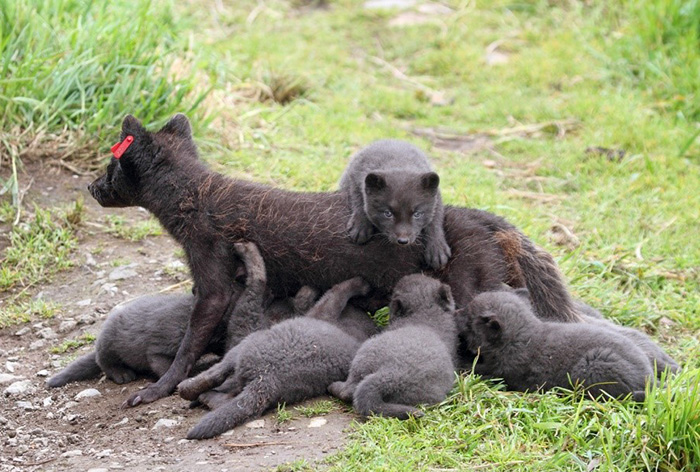
Mother of many children. Family of Arctic foxes. Photograph by Eugene Mamaev
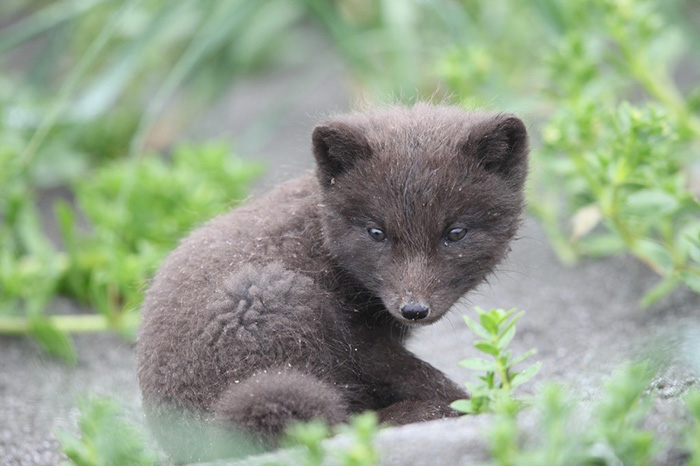
Arctic fox pup. Photograph by Eugene Mamaev
Unlike their continental relatives, living in pairs, Arctic foxes on the Commander Islands form complex families. There can be 3-6 adult Arctic foxes in such families on Medny Island. Among them there can be not only female-helpers which are the offspring of the couple from the previous year, but also breeding females, which live on the territory of a male in other burrows. All in all, the population may have up to 60% such complex families. While puppies do not come out of the burrow males provide females with food. If a male has several females with puppies, it brings food into each of the burrows in turn. As soon as puppies begin to come out of the burrow both parents go for prey, the female during this period goes more often.
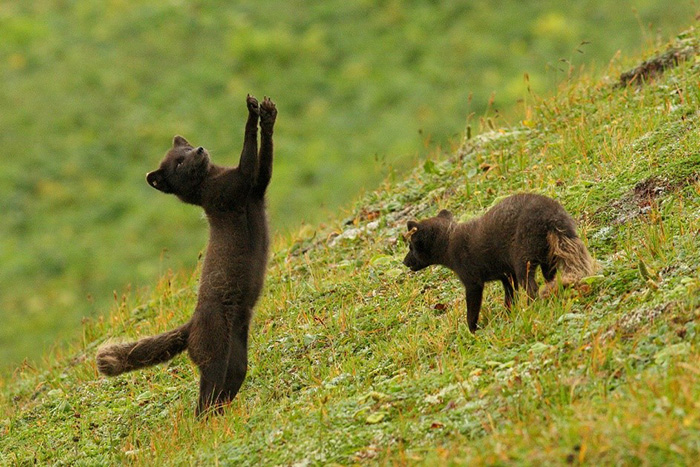
Pair of playing Arctic foxes. Photograph by Eugene Mamaev
The breeding of Arctic fox takes place in burrows which can be rather branched. The depth of their burrows on the islands is not more than 1 m. The burrows have several offshoots. On the Commander Islands there have been observed burrows with 40 offshoots. The burrow has main passes up to 4 m long, with offshoots up to 1,5 m long. The diameter of the hole is 15 - 30 cm. The main nesting place has a width of 60 cm and a height of 50 cm. It is covered with dry grass inside.
In some cases, Arctic foxes can use one burrow for 20 years and in some places for 1-2 years, then leave the burrow and live in another one. After a while, a new couple moves in the burrow, that is how the rotation of inhabited and uninhabited burrows happens. Researchers do not find any absolutely new burrows on the islands, and Arctic foxes use already available ones.
In winter to protect against blizzards Arctic foxes make snowy burrows, digging them in flat snow hills. The length of such burrows is up to 1-1,5 m. Snowy burrows end with a compartment having a width of 40 cm and a height of 25 cm.
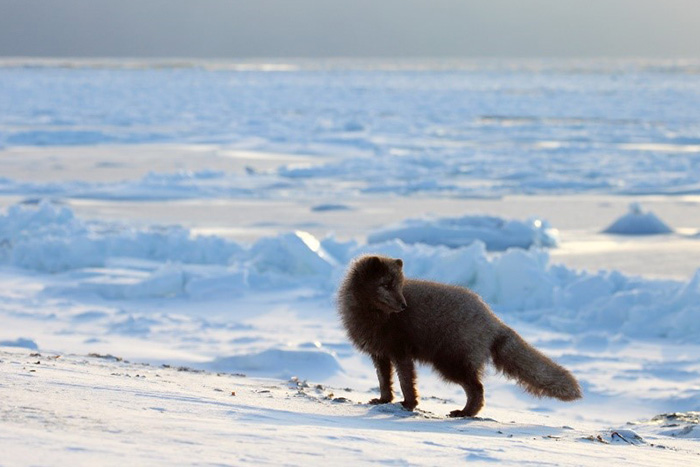
In winter Arctic foxes regularly examine the coast in the search for food. Photograph by Eugene Mamae
After the broods fall apart Arctic foxes settle throughout the island. Males can settle up to 5 km from the parent’s area, females –2 km. At the same time, over 50% of female Arctic foxes on Medny Island stay on the parent’s area or close to it, i.e. barely settle.
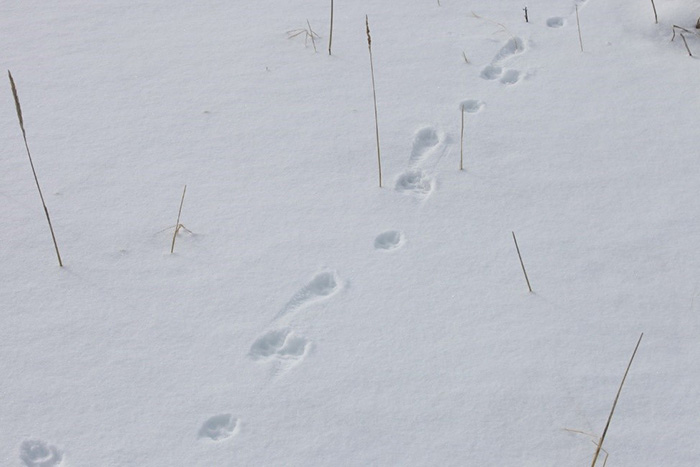
Footprints of an Arctic fox in the snow. Photograph by Eugene Mamaev
The Arctic fox is an omnivorous predator. The ration of the Commander Arctic fox has over 70 different types of feed. During the summer period the ration of the Arctic fox consists mainly of birds and fish. A lot of feed the Arctic fox finds on the rookeries of marine mammals. On Bering Island, which has a well-developed river network, Arctic foxes consume a lot of fish and only in the mountainous southern part of the island they eat mainly birds. On Medny Island the basis of their ration during summer are seabirds. In winter, when seabirds leave the islands, the Arctic fox begins consuming to a greater extent various marine invertebrates, driven ashore.
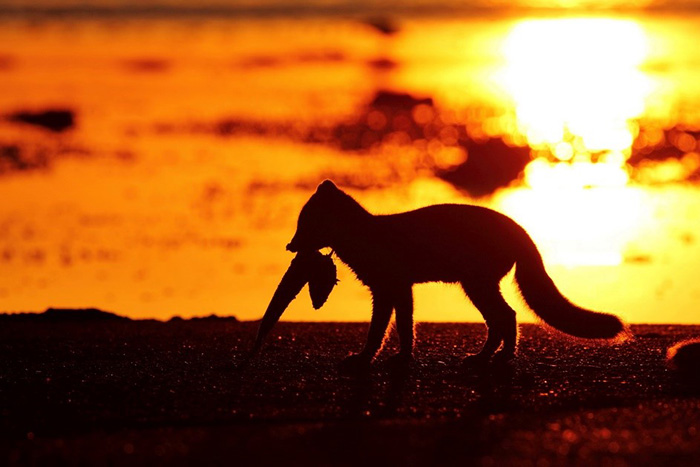
On Bering Island Artic foxes consume Salmonids during the salmon spawning actively. Photograph by Eugene Mamae
An abundant food source for Arctic foxes on the Commander Islands are the rookeries of marine mammals. On rookeries Arctic foxes eat not only carrion but can also kill the pups of the northern fur seal. It has been repeatedly observed by many researchers at all Commander rookeries. In winter, during the most difficult period of life, Arctic foxes consume corpses of marine mammals actively. Usually they are dead sea otters, which inhabit the foreland of the islands all year round. Dozens of Arctic foxes come to the corpses of whales, driven ashore. Once up to 120 Arctic foxes were counted near one corpse of a whale. Arctic foxes wouldn't mind even eating their kin’s corpses.
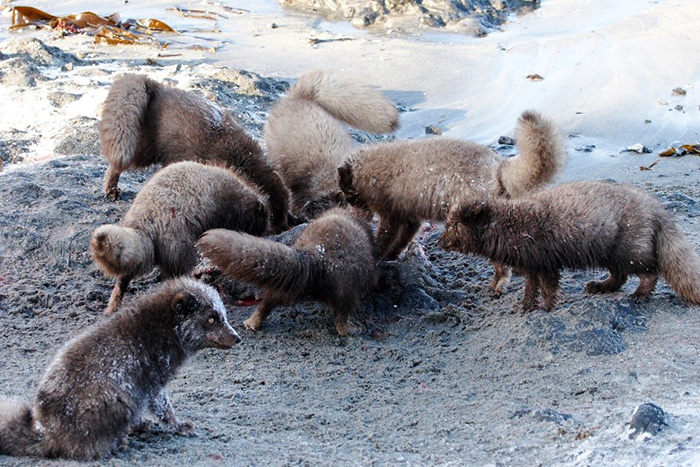
In winter the sea otter corpses are of great importance to the ration of Arctic foxes. Photograph by Eugene Mamaev
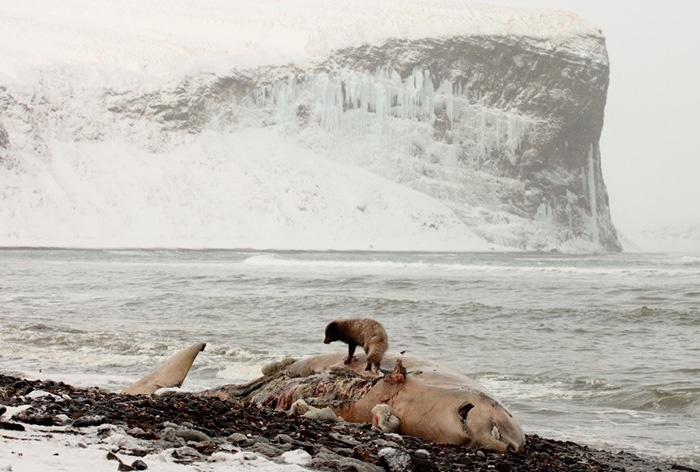
Driven ashore corpses of whales are an important source of food for Arctic foxes in winter on the Commander Islands. Photograph by Eugene Mamaev

In the middle of winter when food is sorely lacking, in order to survive Arctic foxes can eat their kin which haven’t made it through the hunger. Photograph by Eugene Mamaev
In spring Arctic foxes on the littoral area begin to get frogfish –Aptocyclus ventricosus (Pallas, 1769), which during this period of the year comes to the coast and spawn in the littoral zone. After spawning females dive back in the depth while males stay to guard the spawn. Arctic foxes use this feature of the biology of fish. In spring Arctic foxes can often be seen on broad tidal reef plates, scurrying between the puddles in search of food.
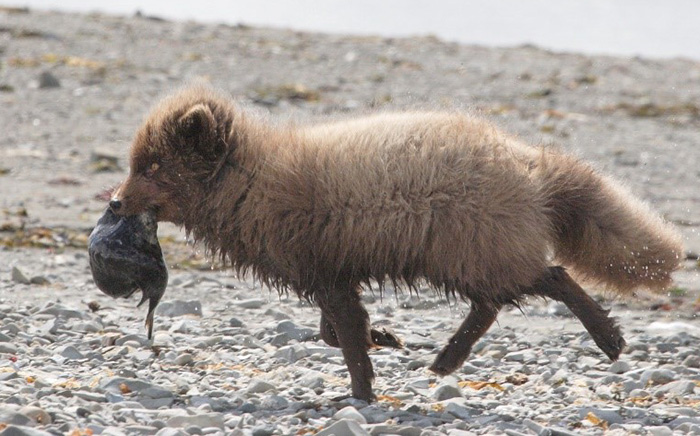
Arctic fox caught a frogfish in the littoral zone. Photograph by Eugene Mamaev
Arctic foxes swim well; they’ve been watched swimming from reef to reef, examining the rookeries of sea otters and northern fur seals in winter. The Arctic fox swims at a speed of 2-2,5 km/h.
In search of food Arctic foxes can run from 30 up to 90 km per day. In normal life, as recent research on the islands has shown, Arctic foxes run about11 km per day on average.
The Arctic fox is active 24 hours a day, but there are peaks of morning activity (from 2 a.m. to 6 a.m.) and evening activity (from 5 p.m. to 10 p.m.).
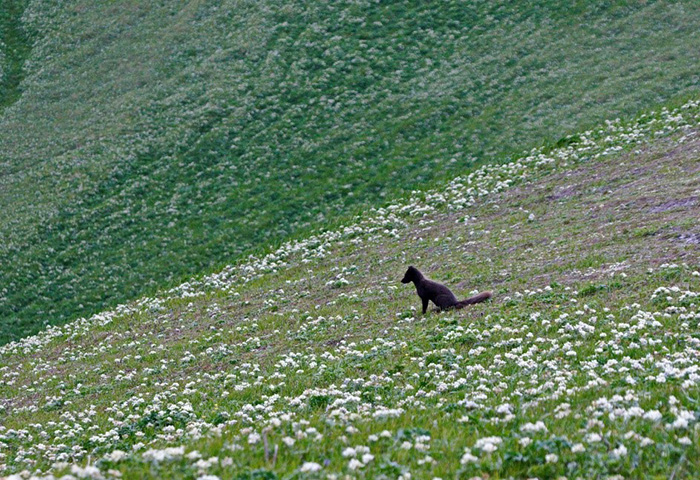
Arctic fox getting a few minutes of leisure. Photograph by Alexey Chetvergov
The Arctic fox was first discovered on Bering Island by Vitus Bering’s expedition in November 1741. The first notes devoted to its appearance and behavioral habits were made by a naturalist of the expedition Georg Wilhelm Steller. He noted their large population and absolute fearlessness towards human.
The Arctic fox, along with sea otters and northern fur seals, has been an object of intensive commercial use on the islands. The maximum which they got on the Commander Islands in one hunting season was 2,5 ths Arctic foxes (in the 90s of the 19th century). At the end of the 19th century in order to reduce the pressure on the populations of Arctic foxes on the islands and not completely exterminate them people started to hunt every other year. Due to its fertility, unpretentiousness regarding habitat conditions and rather stable and abundant feeding conditions, the Arctic fox quickly restored its number. Since the 20s of the last century people started to actively feed Arctic foxes to increase their number. Since the 30s the era of island animal breeding began on the Commander Islands which lasted until the mid-60s. Additional nutrition took place in specially constructed on the territory of the islands trap-feeders (their remains can still be found in some places).
The Arctic fox from Medny Island was always the most valuable during the period of fur trapping. At the time the question was raised about the necessity of a complete extermination of the Bering-Arctic fox and settling on Bering Island the Medny-Arctic fox to improve the quality of fur. After organizing a fur farm on Bering Island in the early 50s Norwegian Arctic foxes began to run away from it, they hybridized with the wild Bering-Arctic fox subspecies. Traces of this hybridization are still noticeable. In the 60s it even got to the point, where they suggested killing the Medny subspecies and replace it with beast breeds.
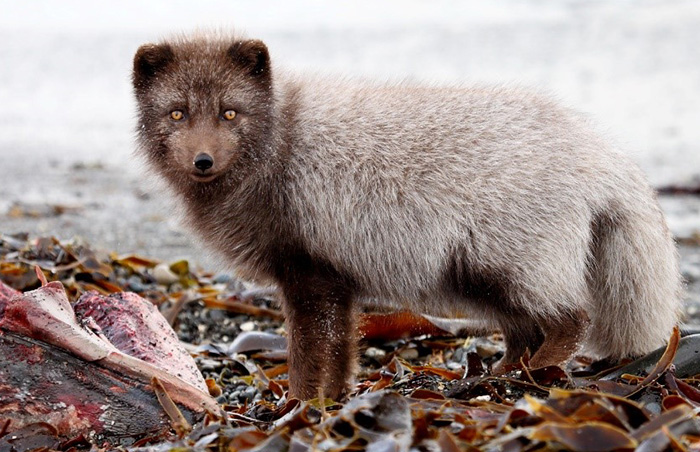
Among wild Arctic foxes of Bering Island here can be found individuals with a typical Norwegian color. Photograph by Eugene Mamaev
The animals from the Commander Islands have been actively used for acclimatization on other islands (see the scheme above). In 1750 Russian industrialists brought Arctic foxes from Bering Island to Attu Island. Further Arctic foxes were brought to a number of other islands of the Aleutian Arc.
While the Bering-Arctic fox was used for acclimatization on the islands of the Aleutian Arc, the Medny-Arctic fox was acclimated to the islands of the Kuril Arc, the Shantar Islands and others.
In 1916 and 1917 Arctic foxes from Medny Island were brought to Ushishir and Matua (the Kuril Islands), and in the 20-30s of the 20th century were settled further south – in Simushir and the islands of Lesser Kuril Ridge. In the 20s Arctic foxes from Medny Island were imported to the Shantar Islands several times. In 1927-29 Arctic foxes from Bering Island were acclimated on Toporkov Island, but after they nearly exterminated the unique seabird colony this experiment was stopped. From several dozens to more than 700 animals per year were exported for settlement from the Commander Islands to different parts of the country in the first half of the 20th century. All this work was carried out as a part of the development of island fur-farming in an attempt to settle different territories by a valuable blue Arctic fox.

Medny-Arctic fox during its «warm-up». Photograph by Eugene Mamaev
In relation to the end of year-round additional nutrition of the Arctic fox on Medny Island in the 50-60s of the 20th century and the damage done to the population by mites Otodectes cynotis in 70-80s of the 20th century its population was reduced from several hundred to several dozen adults. Besides mite infestation an important role in weakening of the population played artificial selection, which probably led to a reduction in the genetic diversity of the population and as a consequence to a decrease in its disease-resistance. The population of Arctic foxes on Medny Island has got through a so-called bottleneck and now has an extremely low genetic variability. Its future raises serious concerns because under certain adverse effects it can die completely. At the same time, the population of the Medny- Arctic fox subspecies is now close to its number during the 20s of the 20th century before the beginning of artificial feeding and probably almost completely corresponds to the modern fodder capacity of the grounds.
Due to its paucity the Medny-Arctic fox subspecies is red-listed in Russia.
At present the number of adult Arctic foxes on Bering Island is estimated at 400-500 individuals, and on Medny Island – 100-120.
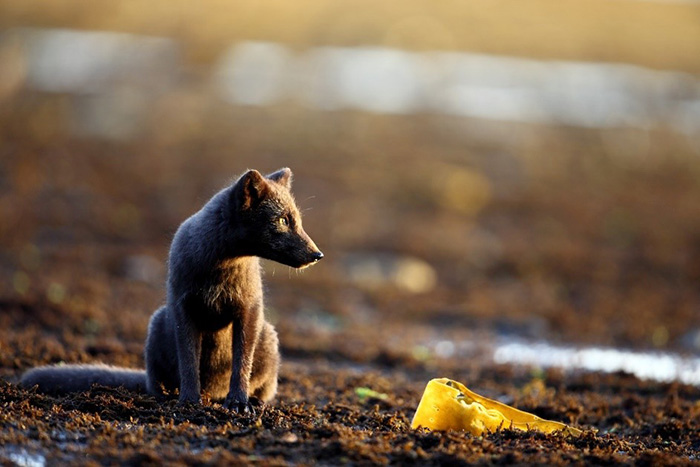
Hopeful look into the future. Photograph by Eugene Mamaev









